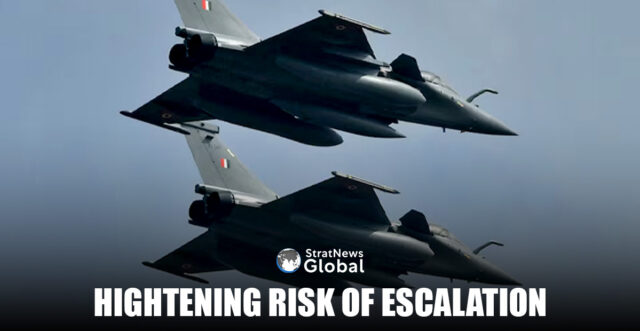India and Pakistan, two nuclear-armed neighbours, have substantially enhanced their military capabilities since their 2019 clash, raising the risk of escalation—even in a limited conflict—according to former military officers and defence analysts.
Pakistan says India plans a military incursion after New Delhi blamed Islamabad for a deadly terror attack on domestic tourists in Jammu and Kashmir’s Pahalgam last month.
Prime Minister Narendra Modi has vowed to punish the backers of the attack “beyond their imagination”.
Pakistan has denied involvement in the attack but has warned it will hit back if it is targeted.
2019 Clash
In 2019, India carried out air strikes inside Pakistan after the bombing of an Indian military convoy in Jammu and Kashmir’s Pulwama and said it destroyed “terrorist camps”.
Pakistani jets conducted a retaliatory air strike and shot down an Indian aircraft during actions spread over two days.
The neighbours have fought three wars – in 1948, 1965 and 1971 – and clashed countless times since gaining independence, mostly over the Kashmir region, which both claim.
Nuclear Arsenal
Both acquired nuclear weapons in the 1990s, and Kashmir is considered one of the most dangerous flashpoints in the world.
Military experts say neither side will consider nuclear weapons unless pushed to the wall, but even a limited conflict would carry high risks of escalation.
They say such a conflict is likely to involve aircraft, missiles or drones, where India and Pakistan are considered closely matched, although India’s far greater resources would come into play over a longer period.
“Decision makers in both states now have a higher risk appetite for conflict initiation and escalation than prior to 2019,” said Frank O’Donnell, a non-resident fellow at the South Asia Program at the Stimson Center, a think-tank in Washington, as they had managed then to clash without nuclear weapons being used.
“But without a clear mutual sense of the precise actions that could trigger inadvertent escalation,” he added.
New Military Hardware
Both sides have acquired new military hardware since 2019, opening up new conventional strike options.
“Each side will think they are in a better position than last time,” said Muhammad Faisal, a South Asia security researcher based at the University of Technology, Sydney. “It is only when we see actual combat that we will find out.”
In particular, India believes that it was at a disadvantage in 2019 because it had to rely mainly on ageing Russian jets. It has since inducted 36 French-made Rafale fighter jets, a top Western aircraft, with more on order for its navy.
Rafale Vs J-10 Jets
To counter, Pakistan got one of China’s most advanced war planes, the J-10, a rough equivalent of the Rafale, in batches since 2022. It has at least 20 of the aircraft, according to the London-based International Institute for Strategic Studies.
The planes carry advanced capabilities, with the Rafale armed with Meteor air-to-air missiles that operate beyond visual range.
The J-10 is armed with the comparable PL-15 missile, according to a Pakistani security official who declined to be identified because they were not authorised to brief the media.
To plug the gaps in air defences exposed on both sides in the 2019 conflict, India secured Russia’s battle-tested S-400, a mobile anti-aircraft missile system. Pakistan obtained the HQ-9 from China, which is based on Russia’s S-300, one notch down.
‘Clamour For Action’
“Most certainly in some respects we are better off (than 2019),” said Anil Golani, a former air vice marshal in the Indian Air Force, and the director general of the Delhi-based Centre for Air Power Studies think tank.
“There’s a lot of clamour for action in the country, but, in my personal assessment, both India and Pakistan are not looking for an all-out conflict,” he added.
Hanging over any conflict is China, India’s rival and Pakistan’s close ally and biggest supplier of military equipment.
Although the U.S. has urged India and Pakistan to ease tensions, it will closely watch any conflict for insights into Beijing’s aerial strength.
The Chinese plane and its PL-15 missile have not previously been tested in combat.
“It could be a contest between Western and Chinese technology,” said Faisal, adding, “for India, there is the dilemma of how many air squadrons to commit to the Pakistan front, as it must also guard against China.”
China and India fought a brief border war in 1962, and the two armies have clashed, most recently in 2022, along their tense Himalayan frontier.
Pakistan’s F-16 Jets
Pakistan has a fleet of F-16s, the U.S. aircraft acquired decades back when ties with Washington were stronger.
These F-16s were deployed in the 2019 tussle, leading India to lodge protests with the U.S., although New Delhi now enjoys far closer ties with Washington.
This time, to avoid the political fallout with the F-16 and to take advantage of having a more advanced aircraft, Pakistan will likely spearhead with the Chinese J-10, experts said.
But a drone or ground-launched missile strike is considered more likely since neither would risk a pilot being shot down.
India has turned to Israel for combat-capable drones, getting the Heron Mark 2, and it has U.S. Predator drones on order.
Pakistan has acquired Turkey’s Bayraktar TB2 – used by Ukraine in its war with Russia – and the Akinci, also from Turkey, according to the Pakistani security official.
Pakistan’s Missile Test
Amid the standoff, Pakistan tested a surface-to-surface ballistic missile with a range of 450 km (280 miles) on Saturday, to show that the armed forces were ready to “safeguard national security against any aggression,” according to a statement from the country’s military.
Pakistan also has a range of short-range and medium-range missiles, capable of being fired from ground, sea and air.
There was no immediate comment from India on the test. India’s capabilities include the BrahMos supersonic cruise missile of about 300 km range as well the Agni series of intercontinental ballistic missiles.
The 2019 skirmish almost spiralled out of control, with multiple missile strikes threatened before U.S. intervention calmed the situation down.
‘India May Strike Harder’
Kaiser Tufail, a former fighter pilot in the Pakistani air force, said that India did not manage to establish deterrence in 2019, so it would aim for a more incisive strike this time, bringing more risks in its wake.
Modi said following the 2019 skirmishes that the country had felt the lack of Rafale fighters at the time, which were on order, and suggested that the results of the clash could have been different if it had the French fighter.
“If you go beyond what we saw in 2019, it is very risky,” said Tufail. “Nuclear-armed countries slugging it out is extremely dangerous.”
(With inputs from Reuters)





